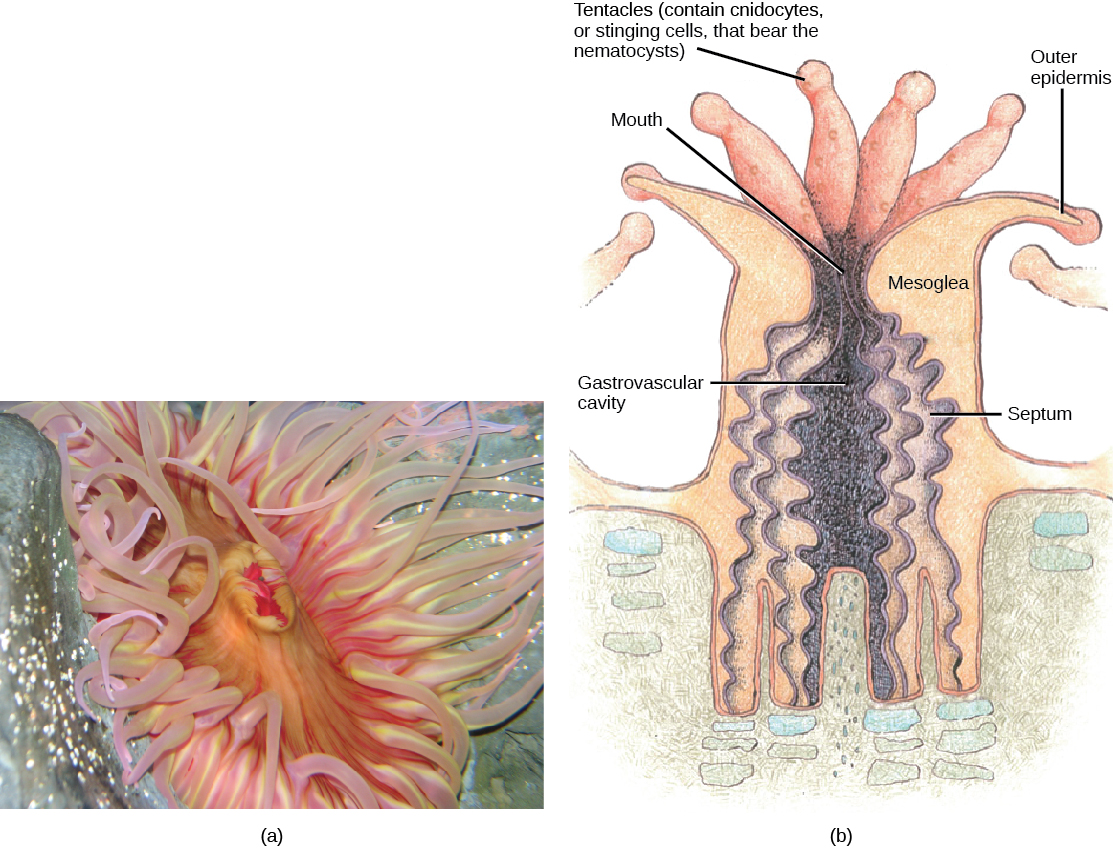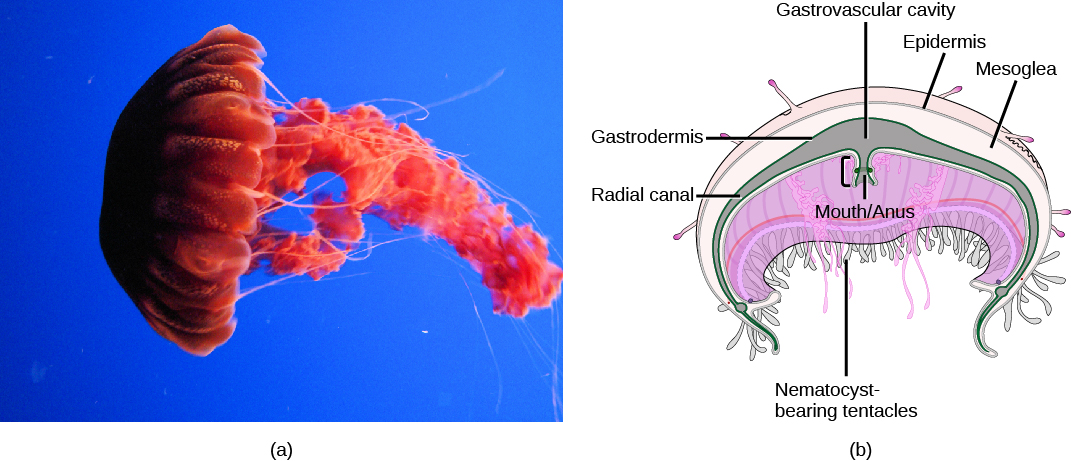Define gastrovascular cavity epidermis gastrodermis cnidocyte. Different Hydra species preferentially live in different habitats and most likely encounter different types of prey Figure 2b.
The invertebrates or Invertebrata are animals that do not contain bony structures such as the cranium and vertebrae.

. Nearly all about 99 percent cnidarians are marine species. The simplest of all the invertebrates are the Parazoans which include only the phylum Porifera. The operculum is a flap of tissue that covers the opening through which the nematocyst exits when released.
Barbs inject poison into prey. The first components to assemble in initiation are the large ribosomal subunit mRNA and the initiator tRNA molecule. Essentials of Biology 4 th Edition page 342343 1922 Distinguish between a parazoan and an eumetazoan and give an example of each.
When stimulated water rushes into the capsule. Thus TRGs might contribute to the diversity of structures cnidocytes. What is the difference between radial and bilateral symmetry.
The final cnidocyte in the diagram has an extended nematocyst. Whereas the defining cell type for the sponges is the choanocyte the defining cell type for the cnidarians is the cnidocyte or stinging cell. Sponge larvae are able to swim.
Biology 106 Spring 2022 Having an exoskeleton means the animal must molt in order to grow. Phylum Porifera pori pores fera bearers are popularly known as sponges. Nearly all about 99 percent cnidarians are marine species.
The operculum cap opens and rapidly launches the filament. Nearly all about 99 percent cnidarians are marine species. Cnidocyte discharge in vivo typically requires the near simultaneous application of chemical and mechanical stimuli 24The mechanosensory aspect of discharge is mediated by stimulation of the cnidocyte cnidocil which is essentially a finger-like projection at the apical.
What are the different body forms of Cnidarians. Cnidaria n ɪ ˈ d ɛər i ə n aɪ- is a phylum under kingdom Animalia containing over 11000 species of aquatic animals found both in freshwater and marine environments predominantly the latter. Cnidocyst discharge is still poorly understood owing to the nanosecond duration of the process.
In what ways are incomplete and complete metamorphosis different. But with all types of vaccines the body is left with a supply of memory T-lymphocytes as well as B-lymphocytes that. Different types of vaccines work in different ways to offer protection.
Cnidarians contain specialized cells known as cnidocytes stinging cells which contain organelles called nematocysts stingers. COVID-19 vaccines help our bodies develop immunity to the virus that causes COVID-19 without us having to get the illness. How does a cnidocyte function in capturing prey.
Give example of animals of each type and describe how they move feed and sense their environment. Phylum Cnidaria includes animals that show radial or biradial symmetry and are diploblastic that is they develop from two embryonic layers. Barbed ends often laced with venom contribute to the potency of a nematocyst sting.
Request PDF The regulation of cnidocyte discharge Because cnidocytes are exceedingly complex cells which can only be used once their discharge. The insect fighting chemicals therefore evolved through the process called. Later plants produced more toxic versions of these chemicals which now protect many plants from being eaten by insects.
Define each one and give an example of each process3. Give an example of two animals exhibiting each type of feeding mode2. They develop from two embryonic layers.
At least four different types of gland cells have been identified across the life history of N. Toxins can be delivered using two different cell types. Explain what molting and ecdysis are.
Phylum Cnidaria includes animals that show radial or biradial symmetry and are diploblastic. Taken together the invention of a new morphological feature such as the cnidocyte seems to be tightly interlinked with the evolution of TRGs. These cells are present around the mouth and.
How COVID-19 Vaccines Work. A previous study of stem cell dynamics in Hydra identified a six-domain C 2 H 2 zinc finger transcription factor called ZNF845 as a general marker of the multipotent interstitial stem cell lineage To determine if this gene played a role in marking multipotent stem cells in other cnidarians we examined the spatial expression and function of the ZNF845. Describe each List and describe the major groups of arthropods identify them based on the number of legs and the tagma they have.
Parazoa are an ancestral subkingdom of animals literally translated as beside the animals. Nearly all about 99 percent cnidarians are marine species. Their distinguishing feature is cnidocytes specialized cells that they use mainly for capturing preyTheir bodies consist of mesoglea a non-living jelly-like substance sandwiched.
What are the different modes of feeding described in the text. The second cnidocyte has been activated and is beginning to be released. Whereas the defining cell type for the sponges is the choanocyte the defining cell type for the cnidarians is the cnidocyte or stinging cell.
Plant scientists explain that the earliest land plants produced chemicals called flavonoids that helped protect their cells from UV light damage. A cnidocyte also known as a cnidoblast or nematocyte is an explosive cell containing one large secretory organelle called a cnidocyst also known as a cnida pl. List out all of the compartments found in the digestive systems of different.
The echinoderms exhibit pentaradial body plans. Nematocytes which develop as early as 48 hpf in the swimming planula and gland cells loaded with venom components and found even earlier at the gastrula stage Fig. Cnidae or nematocyst that can deliver a sting to other organismsThe presence of this cell defines the phylum Cnidaria corals sea anemones hydrae jellyfish etcCnidae are used to capture prey and as a defense against.
Cnidaria corals jellyfish sea anemones and hydroids is a phylum of aquatic animals unified by the presence of specialized stinging cells called cnidocytes These beautiful and exotic creatures have fascinated biologists since the dawn of experimental biology 2 3Their phylogenic position as the sister group to Bilateria makes them key to. Cnidarians contain specialized cells known as cnidocytes stinging cells containing organelles called nematocysts stingers. Specialized for prey capture and defense cnidocytes are morphologically complex and vary widely in.
What are the four stages of food processing that occur in the digestive system. Phylum Cnidaria includes animals that exhibit radial or biradial symmetry and are diploblastic meaning that they develop from two embryonic layers ectoderm and endoderm. Each cnidocyte has a capsule called a mematocysy containing a long hollow thread.
Cnidocytes are the explosive stinging cells found only in cnidarians corals jellyfish etc. A peptide bond forms between the new amino acid and the amino acid at the C-terminus of the growing polypeptide chain. Phylum Cnidaria includes animals that exhibit radial or biradial symmetry and are diploblastic meaning that they develop from two embryonic layers ectoderm and endoderm.

Learn About Cnidocytes Chegg Com



0 Comments